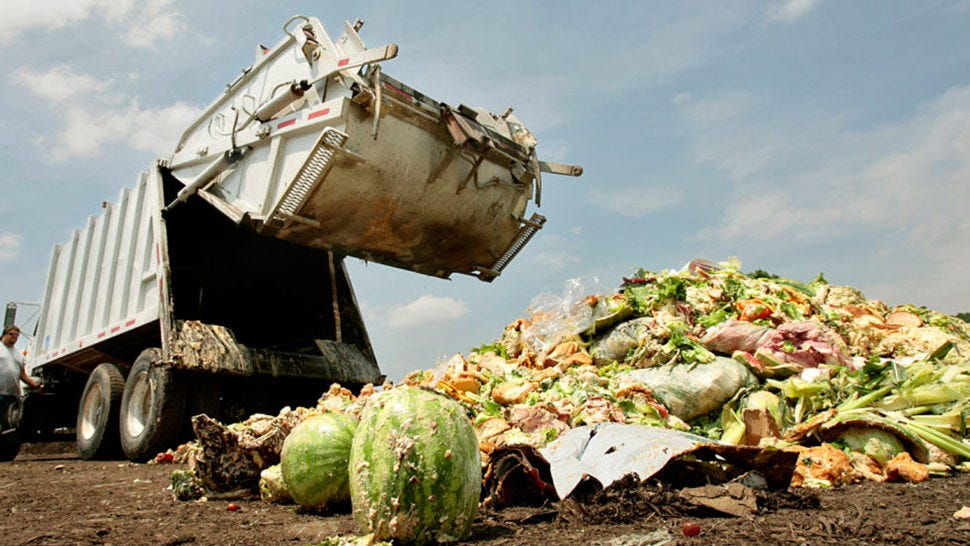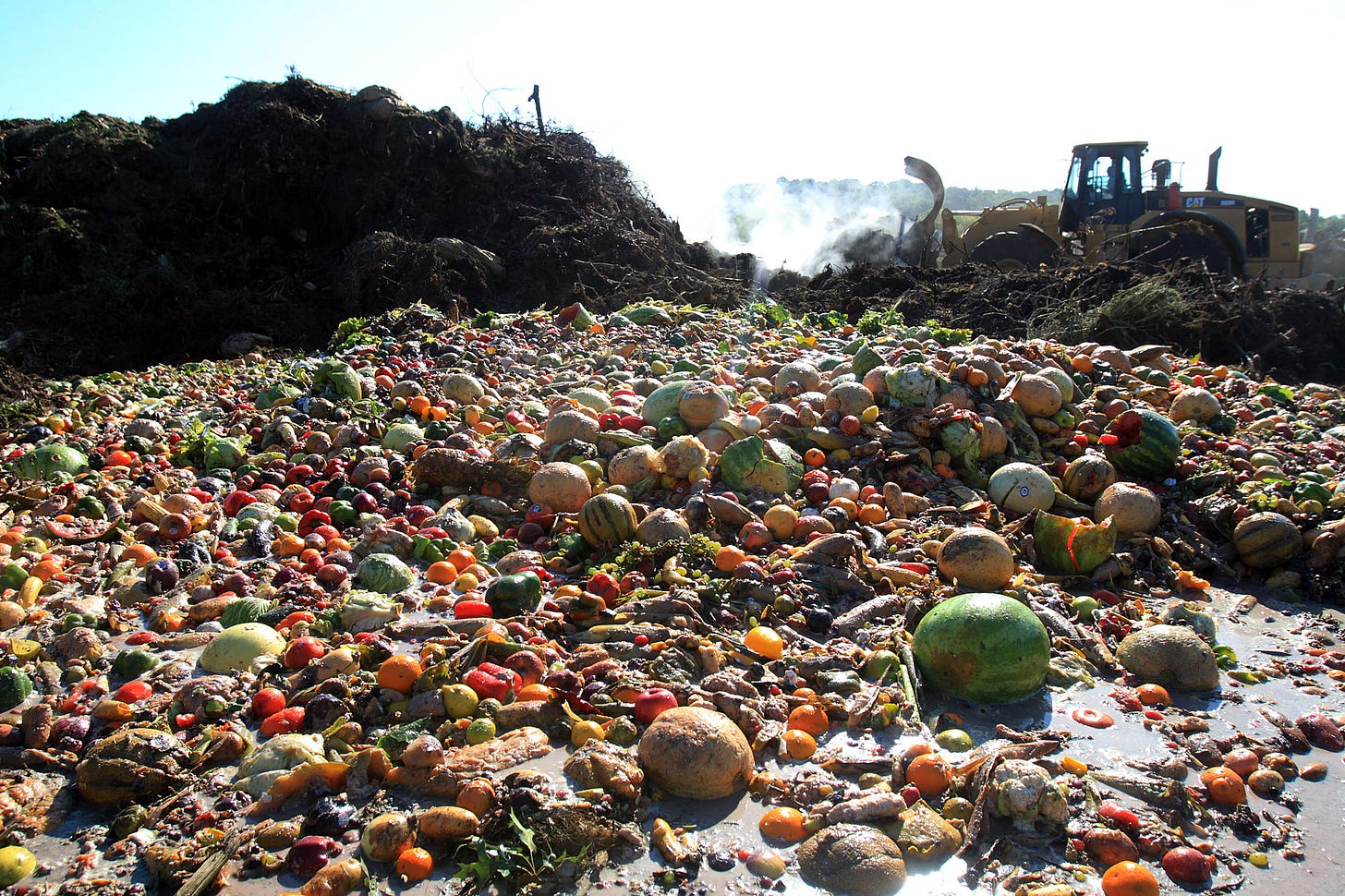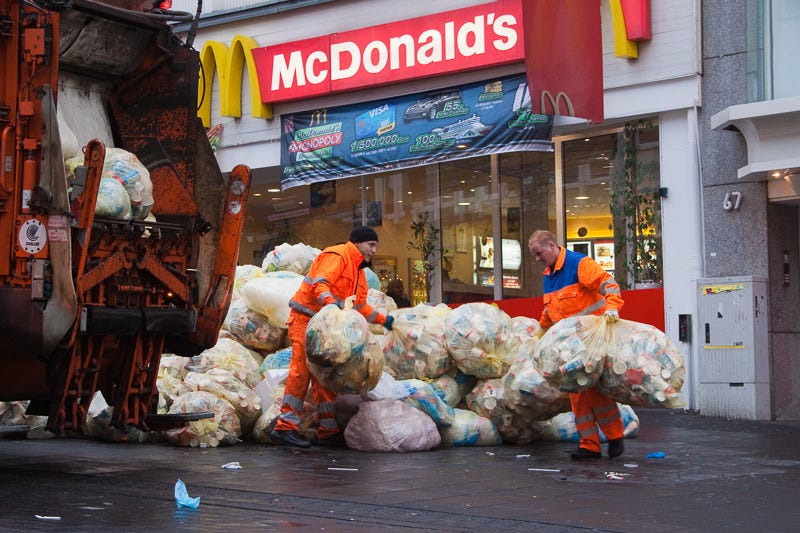The greatest blessings of mankind are within us and within our reach.
A wise man is content with his lot, whatever it may be, without wishing for what he has not.
– Seneca
One thing that is wasted in enormous amounts across the world and that which sustains life is food. Even though there are those in the world who are hungry or starving, there is still a massive amount of food wasted daily. Nearly 800 million people worldwide suffer from hunger. At the same time, about one-third of food is squandered,[i] or about 1.6 billion metric tons (1.76 billion tons) a year, equal to the weight of over 4,800 Empire State Buildings, with a value of about $1 trillion. If this wasted food were stacked in a 20-cubic meter bin, it would fill 80 million of them, enough to reach all the way to the moon and encircle it once. The wasted food is enough to feed the hungry twice over.[ii]
At least 1.3 billion tons of food is lost or wasted every year — in fields, during transport, in storage, at restaurants, and in markets in industrialized and developed countries alike. In rich countries alone, some 222 million tons of food [are] wasted, which is almost as much as the entire net food production of sub-Saharan Africa.[iii]
There is a vast “farm to the fork to the landfill” problem in the United States, with 40% of food going to waste and the uneaten food ending up rotting in landfills.[iv] Roughly 50% of all produce is thrown away, weighing 60 million tons annually, worth $160 billion.[v] Families throw out approximately 25% of the food and beverages they buy.[vi] One analysis found that students discarded roughly 40% of their fruits and 60 to 75% of their vegetables from their school lunches.[vii]
It’s not only the food that is wasted but also all of the water, fertilizer, pesticides, seeds, fuel, and land squandered to grow it. This has a significant environmental impact, with the uneaten food utilizing as much water as the entire annual flow of the Volga River, Europe’s most voluminous river, each year.[viii]
About one-quarter of produced food is lost along the food-supply chain. The production of this lost and wasted food accounts for 24 percent of the freshwater resources used in food-crop production, 23 percent of total global cropland area, and 23 percent of total global fertilizer use.[ix]
In the United States, the Environmental Protection Agency (EPA) estimates that more food reaches landfills and incinerators than any other single material in our everyday trash, accounting for about 21% of the waste stream.[x] Food production uses up 10% of the total energy budget, 50% of the land, and 80% of all freshwater consumed.
Growing food releases hundreds of millions of pounds of pesticides into the environment each year, leading to water quality impairment in the nation’s rivers and streams. The energy used from agriculture, transportation, processing, food sales, storage, and preparation to produce the 133 billion pounds of food that retailers and consumers throw out in the United States yearly is massive. It is equivalent to more than 70 times the amount of oil lost in the Gulf of Mexico’s Deepwater Horizon disaster.[xi]
Americans are wasting more of the food they buy. The average American wastes 10 times as much food as someone in Southeast Asia, 50% more than Americans in the 1970s.[xii] Unfortunately, with increasing prosperity comes a generally indifferent attitude towards readily available and easily accessible food. Since, for many people, food represents a small portion of many Americans’ overall budgets, food waste has become relatively unimportant. From an economic perspective, the more food consumers waste, the more profits the food industry makes. Any waste downstream in the food supply chain means more sales and profit for anyone upstream.
American consumers have also come to expect a level of quality in the produce they purchase. A great deal of produce is culled and thrown away if it does not meet specific, unrealistic, and stringent cosmetic standards of size, color, and weight, as well as being free from blemishes.[xiii]
A large tomato-packing house reported that in mid-season, it can fill a dump truck with 22,000 pounds of discarded tomatoes every 40 minutes. And a packer of citrus, stone fruit, and grapes estimated that 20 to 50 percent of the produce he handles is unmarketable but perfectly edible.
In recent years, supermarkets have started running their produce departments like beauty pageants. They say they are responding to customers who expect only ideal produce.[xiv] Unfortunately, the demand for “perfect” fruit and vegetables means many are discarded and left in the field to rot, even though blemishes do not necessarily affect freshness or quality. This demand for flawless-looking fruits and vegetables results in as much as half of the food grown in the United States being thrown away.[xv]
“It’s all about blemish-free produce,” says Jay Johnson, who ships fresh fruit and vegetables from North Carolina and central Florida. “What happens in our business today is that it is either perfect, or it gets rejected. It is perfect to them, or they turn it down. And then you are stuck.”[xvi]
Food waste is a staggering global issue, with nearly one-third of all food produced going to waste while millions suffer from hunger. The scale of this waste is monumental, with over 1.6 billion metric tons discarded annually, enough to feed the world's hungry more than twice over. The environmental impact is equally dire, with wasted resources such as water, land, and energy contributing significantly to the problem. In developed nations, such as the United States, the culture of perfection in food appearance leads to large amounts of produce being discarded for minor cosmetic imperfections. Food waste not only contributes to economic inefficiencies but also intensifies environmental degradation, highlighting the urgent need for systemic changes in production, consumption, and societal attitudes towards food. Addressing this issue requires rethinking our entire food supply chain, from farming practices to consumer habits, to reduce waste and ensure that food reaches those who need it most.
Roman Bystrianyk's research and writing are made possible by reader support. To stay informed and help sustain my work, consider subscribing—either for free or with a paid membership. Thank you!
Parts of this article are from my new book, Moving Back From Midnight, which is available on Amazon.
https://movingbackfrommidnight.com/
[i] Suzanne Goldenberg, “Half of all US food produce is thrown away, new research suggests,” The Guardian, July 13, 2016, https://www.theguardian.com/environment/2016/jul/13/us-food-waste-ugly-fruit-vegetables-perfect
[ii] Elizabeth Royte, “How ‘Ugly’ Fruits and Vegetables Can Help Solve World Hunger,” National Geographic, March 2016, https://www.nationalgeographic.com/magazine/2016/03/global-food-waste-statistics/
[iii] Reynard Loki, “America is a wasteland: The U.S. produces a shocking amount of garbage,” Salon, July 15, 2016, https://www.salon.com/2016/07/15/america_is_a_wasteland_the_u_s_produces_a_shocking_amount_of_garbage_partner
[iv] Dana Gunders, Wasted: How America Is Losing Up to 40 Percent of Its Food from Farm to Fork to Landfill, Natural Resources Defense Council, August 2012.
[v] Adam Chandler, “Why Americans Lead the World in Food Waste,” The Atlantic, July 15, 2016, https://www.theatlantic.com/business/archive/2016/07/american-food-waste/491513
[vi] Dana Gunders, Wasted: How America Is Losing Up to 40 Percent of Its Food from Farm to Fork to Landfill, Natural Resources Defense Council, August 2012.
[vii] Ariana Eunjung Cha, “Why the healthy school lunch program is in trouble. Before/after photos of what students ate,” Washington Post, August 26, 2015.
[viii] Elizabeth Royte, “How ‘Ugly’ Fruits and Vegetables Can Help Solve World Hunger,” National Geographic, March 2016, https://www.nationalgeographic.com/magazine/2016/03/global-food-waste-statistics
[ix] Water pollution from agriculture: a global review - Executive summary, FAO & IWMI, 2017.
[x] United States 2030 Food Loss and Waste Reduction Goal, EPA (Environmental Protection Agency)
[xi] Elizabeth Royte, “How ‘Ugly’ Fruits and Vegetables Can Help Solve World Hunger,” National Geographic, March 2016, https://www.nationalgeographic.com/magazine/2016/03/global-food-waste-statistics
[xii] Dana Gunders, Wasted: How America Is Losing Up to 40 Percent of Its Food from Farm to Fork to Landfill, Natural Resources Defense Council, August 2012.
[xiii] Dana Gunders, Wasted: How America Is Losing Up to 40 Percent of Its Food from Farm to Fork to Landfill, Natural Resources Defense Council, August 2012.
[xiv] Elizabeth Royte, “How ‘Ugly’ Fruits and Vegetables Can Help Solve World Hunger,” National Geographic, March 2016, https://www.nationalgeographic.com/magazine/2016/03/global-food-waste-statistics/
[xv] Suzanne Goldenberg, “Half of all US food produce is thrown away, new research suggests,” The Guardian, July 13, 2016, https://www.theguardian.com/environment/2016/jul/13/us-food-waste-ugly-fruit-vegetables-perfect
[xvi] Suzanne Goldenberg, “The US throws away as much as half its food produce,” Wired, July 14, 2016, https://www.wired.com/2016/07/us-throws-away-much-half-food-produce








Vitally important issue. Misdirected and misused resources, squandered for profit and conditioned preferences. Most of this out of sight and out of mind for a huge majority of people, but so important to consider deeply.
Waste (of nearly everything) is a huge bane and failing of the current system.
I agree hole-heartedly with Inverted Reality. Would like to add that if food was produced in the natural non-toxic way it would cost more, so people would buy less of it and it would actually be nutritious, so a person would need to eat much less of it than the mass-produced crap today to feel sated. In our family we grow a garden and raise our own animals for eggs and meat. We have very little waste which all goes to the animals or on the garden for compost. I also make all our breads and such from grain that we grind ourselves. Before I cook it I either ferment the flour or sprout the grain, so it takes a lot of time and extra efforts to produce healthy food. I often think that if the majority of people in the US all of a sudden realized how toxic the food in supermarkets is and decided to eat healthy there would be a famine. It makes me so sick to see the endless sea of corn and soybean fields, millions of acres of toxic crap that feeds all the animals raised in confinement to produce nutritionally depleted eggs, dairy and cancerous meat. All of these fields need to be seeded with a variety of natural grasses and turned into pasture for cows and sheep and the vast woodlands need to become pasture for hogs. All the production of desease generating vegetable oils needs to cease and be replaced with butter, lard and tallow. None of this will happen until the public realizes that the food they buy cheap and so much of is killing them.